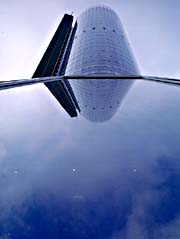- Natural Environment in Essen
The climate of Essen can be said to be moderate (please refer to the annual average temperatures and humidity on the graph). But, while the average temperature in winter is 4'C, the lowest recorded temperature of -9'C is considered severe. On the other hand, it is relatively pleasant in summer. Still the heat emitted from electric appliances and the people in the building would be considerable and also the solar radiation could be guaranteed to raise the temperature considerably, if no measures to control the heating effect of the large window area were available.
Consequently, it was necessary for the RWE Tower's outer skin to receive moderate solar radiation during the cold season, and to shut out solar radiation as well as allow the inner heat out during the hot season.
Wind also is a great influencing factor for a high-rise with natural ventilation. The wind in Essen is relatively modest too, as the velocity is some 4.0m on average and less than 17.0m at maximum, blowing mainly from the south, south-west and west. At the 120m point near the top of the tower, the wind velocity is some 20% greater than that measured at the meteorological station.
- Energy Saving Policies in Germany and the Intentions of RWE AG
In Japan, many people consider that environment-conscious design and planning are inherent in architecture and cities in Germany. Indeed, in some cities there, autos are restricted in the central area, and trash and waste are recycled to a great extent. It is also common sense in Germany to use pair glass in office buildings as well as residential houses.
However, Nagel pointed out that no standard nor subsidy grant is available for the energy saving features of the buildings whereas some official money is paid to residential properties.
RWE AG, the user of the tower, also does not appear to have been very interested in energy saving in the earliest stage of the project. But, as the design progressed, the tower has come to be a symbol for both energy-related enterprise and for corporate openess, due to its energy- saving performance and its transparency. Also, Nagel suggested that the buildings were going to be required to have energy saving performance, because environmentalists had been more influential since the recent change of government.
Previous Page |
Next Page |
